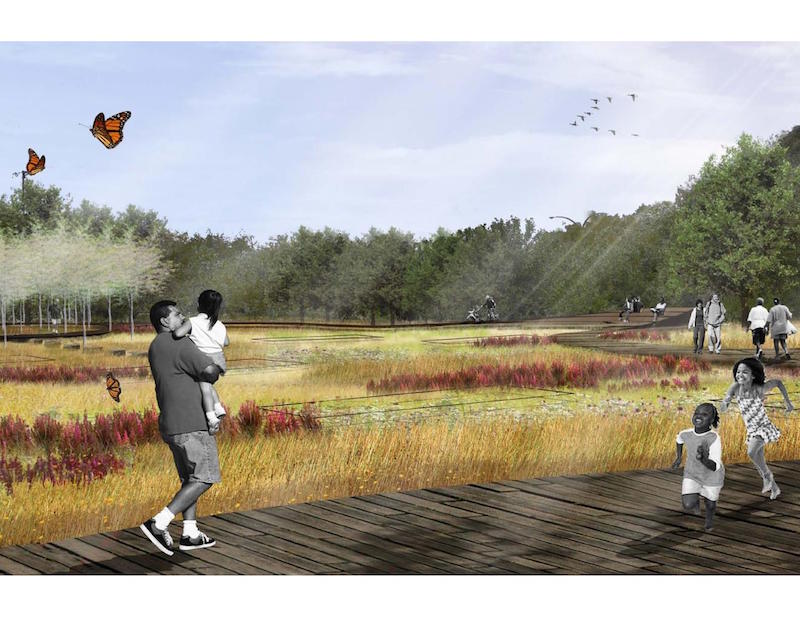The TKF Foundation is a 10-year-old private nonprofit that specializes in creating open, public sanctuaries. Since its founding, TKF has supported the creation of more than 130 Open Space Sacred Places in the Baltimore-Annapolis-Washington area alone.
“We envision a time when every urban community in the U.S. will provide people with opportunities for intimate, intentional daily doses of nearby urban nature through the creation of a system of nature spaces,” says the Foundation’s mission statement.
On May 20, The Naval Cemetery Landscape, a 1.7-acre public space on the site of a former Naval Cemetery on the waterfront in Brooklyn, N.Y., opened. This is the sixth nationally funded site where TKF and its research partners are studying the relationship of nature and human resiliency, and specifically the impact that proximity to nature has on a person’s ability to recover from psychological, social, or physiological stresses.
A team led by Denise Milstein, Director of Columbia University’s Master’s degree program in Sociology, is conducting the study at the cemetery site, which focuses on students of the Brooklyn Green School and on residents of Brooklyn Housing and Community Services.
“It is an excellent example of how green space can foster social cohesion, and the research being done here should offer insights for other city planners on the value such spaces bring to cities and their residents,” said Tom Stoner, TKF’s 81-year-old co-founder.
The Foundation selected the Naval Cemetery Landscape project from 126 that responded to its RFP for a grant. TKF visited more than 30 sites over an 18-month period before making its choice, says Jayne Trentanove, a Foundation spokesperson.
The project is the first open space of the Brooklyn Waterfront Greenway, which when completed will comprise a 27-mile route for pedestrians and cyclists that connects neighborhood parks and open spaces from the Greenpoint section of Brooklyn to Jamaica Bay, Queens.
The Naval Cemetery Landscape’s development was spearheaded by the nonprofit Brooklyn Greenway Initiative in partnership with the Brooklyn Navy Yard Development Corporation.
“As we approach Memorial Day, we are reminded of the significant military history of the Yard, and through the thoughtful landscape design, we hope to honor those roots,” said David Ehrenberg, President and CEO of the Brooklyn Navy Yard.
Marvel Architects and Nelson Byrd Woltz Landscape Architects designed the site in a way that respects its history as a burial ground. New York’s Department of State collaborated on this project, in that since 2004 it has awarded five Environmental Protection grants totaling $3,318,000 to the Brooklyn Greenway Initiative and the Brooklyn Borough President’s office.
The former Brooklyn Naval Hospital Cemetery site is located in the southeast corner of the Brooklyn Navy Yard. The cemetery had been active from 1834 through 1910, and was a burial site for more than 2,000 people. In 1926, the Navy sought to move all remains and inter them at nearby Cypress Hills National Cemetery.

The 1.7-acre Naval Cemetery Landscape is serving as a research site studying the importance of nearby nature of human resiliency, and to evaluate how proximity to landscape affects human well-being. Image: Marvel Architects and Nelson Byrd Woltz Landscape Architects.
Establishing a legacy
TKF Foundation will be closing its doors in December 2017, says Trentanove. But it has laid the groundwork for future urban landscape and restorative places through the research it has conducted over the years, the open spaces it has helped create, and through its national grant program that has provided $4.5 million for six research projects.
Aside from the naval cemetery site, its other grant projects include:
•The Green Road, a woodlands path that runs through the campus of Walter Reed National Military Medical Center in Bethesda, Md. It provides “an oasis of respite” for wounded soldiers and their families, as well as a patient-centered approach to healing;
•A Nature Place in Portland, Ore., where the roof of Legacy Emanuel Medical Center was converted into a 6,500-sf healing and restorative garden that’s open to the public, but whose main purpose is to provide a calming area for the facility’s Cardiovascular ICU and its Family Birthing Center. The effect of that space on patients and their families, on nurses, and on post-partum mothers is being studied;
•TKF has two “Landscapes of Resilience” research sites where the organization and its partners are analyzing how the natural environment can influence and help restore places in crisis. One site—Butterfly Garden & Overlook—is located in Joplin, Mo., on land where homes were wiped out by an E-5 tornado five years ago. A second, under development, is recreating a community garden and large gathering place on the edge of Jamaica Bay in Queens, N.Y. It is located adjacent to two senior citizen housing towers that were severely damaged by Hurricane Sandy;
•TKF is also funding research on why nature improves health outcomes. A team of researchers, led by Marc Berman of the University of Chicago, is evaluating the effects of nature on cognitive functioning. One of the team’s goals is to create a kind of guide that would inform urban planners about what elements they should include in future projects that are most likely to attract people.
A second study, conducted by a team from the University of Illinois at two of TKF’s older sites in Baltimore, is looking at different populations and how spending time in natural settings affects one’s immune system.
Related Stories
| Aug 11, 2010
Modest recession for education construction
Construction spending for education expanded modestly but steadily through March, while at the same time growth for other institutional construction had stalled earlier in 2009. Education spending is now at or near the peak for this building cycle. The value of education starts is off 9% year-to-date compared to 2008.
| Aug 11, 2010
Manhattan's Pier 57 to be transformed into $210 million cultural center
LOT-EK, Beyer Blinder Belle, and West 8 have been selected as the design team for Hudson River Park's $210 million Pier 57 redevelopment, headed by local developer Young Woo & Associates. The 375,000-sf vacant passenger ship terminal will be transformed into a cultural center, small business incubator, and public park, including a rooftop venue for the Tribeca Film Festival.
| Aug 11, 2010
Opening night close for Kent State performing arts center
The curtain opens on the Tuscarawas Performing Arts Center at Kent State University in early 2010, giving the New Philadelphia, Ohio, school a 1,100-seat multipurpose theater. The team of Legat & Kingscott of Columbus, Ohio, and Schorr Architects of Dublin, Ohio, designed the 50,000-sf facility with a curving metal and glass façade to create a sense of movement and activity.
| Aug 11, 2010
Curtain rises on Broadway's first green theater
The Durst Organization and Bank of America have opened New York's first LEED-certified theater, the 1,055-seat Henry Miller's Theatre. Located inside the new 55-story Bank of America Tower at One Bryant Park, the 50,000-sf theater is located behind the preserved and restored neo-Georgian façade of the original 1918 theater.
| Aug 11, 2010
Restoration gives new life to New Formalism icon
The $30 million upgrade, restoration, and expansion of the Mark Taper Forum in Los Angeles was completed by the team of Rios Clementi Hale Studios (architect), Harley Ellis Devereaux (executive architect/MEP), KPFF (structural engineer), and Taisei Construction (GC). Work on the Welton Becket-designed 1967 complex included an overhaul of the auditorium, lighting, and acoustics.
| Aug 11, 2010
Concrete Solutions
About five or six years ago, officials at the University of California at Berkeley came to the conclusion that they needed to build a proper home for the university's collection of 900,000 rare Chinese, Japanese, and Korean books and materials. East Asian studies is an important curriculum at Berkeley, with more than 70 scholars teaching some 200 courses devoted to the topic, and Berkeley's pro...
| Aug 11, 2010
Piano's 'Flying Carpet'
Italian architect Renzo Piano refers to his $294 million, 264,000-sf Modern Wing of the Art Institute of Chicago as a “temple of light.” That's all well and good, but how did Piano and the engineers from London-based Arup create an almost entirely naturally lit interior while still protecting the priceless works of art in the Institute's third-floor galleries from dangerous ultravio...
Cultural Facilities | Aug 11, 2010
12 major trends in library design
Many academic planners assumed that the coming of the Internet would lead to the decline of the library as we know it. To the contrary, many academic libraries have experienced significantly increased patron use in recent years.
| Aug 11, 2010
Bronze Award: John G. Shedd Aquarium, Chicago, Ill.
To complete the $55 million renovation of the historic John G. Shedd Aquarium in the allotted 17-month schedule, the Building Team had to move fast to renovate and update exhibit and back-of-house maintenance spaces, expand the visitor group holding area, upgrade the mechanical systems, and construct a single-story steel structure on top of the existing oceanarium to accommodate staff office sp...
| Aug 11, 2010
Great Solutions: Green Building
27. Next-Generation Green Roofs Sprout up in New York New York is not particularly known for its green roofs, but two recent projects may put the Big Apple on the map. In spring 2010, the Lincoln Center for the Performing Arts will debut one of the nation's first fully walkable green roofs. Located across from the Juilliard School in Lincoln Center's North Plaza, Illumination Lawn will consist ...








